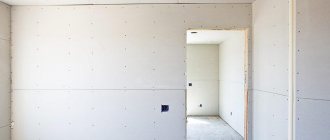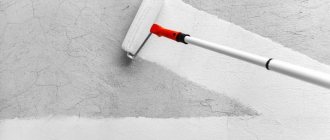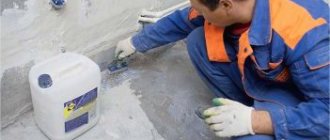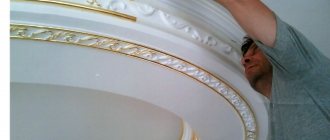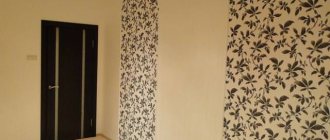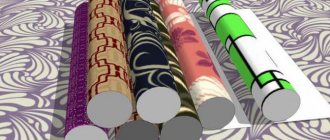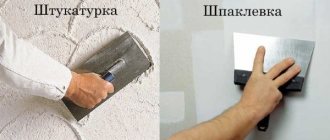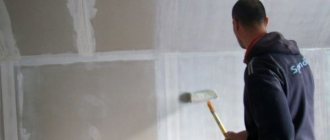0
20.06.2018
When carrying out renovations of residential premises and external walls with your own hands, a lot of questions arise. Most of them, to one degree or another, address the issue of treating walls to level them by applying putties and primers. Let us consider what needs to be done and in what cases, and in what cases the need will not arise at all.
The article will discuss the issue related to priming surfaces made of various materials.
The necessity and significance of preliminary, repeated and intermediate priming between layers, one or more, will be presented, depending on the technique of applying the compositions and their use on the surface.
Are walls primed before applying putty?
It is known that priming is a mandatory step prior to any subsequent processing. However, first of all, it is important to understand what a primer is, what its properties are, and in what situations its use is most justified.
The primer is used for those surfaces that should look aesthetically pleasing. If we are talking about domestic premises or surfaces completely hidden by furniture or other objects, then the feasibility of using a primer becomes minimal.
Sequence of priming work
When it is decided to carry out renovations in an apartment with their own hands, newly minted craftsmen are concerned with the question: how to prime the walls before puttying? The entire process of priming work can be divided into several successive stages.
Preparatory stage
The first priority is to prepare the walls. They should be cleaned of dirt, dust, and old coating if it has begun to peel away from the base. You also need to make sure that the walls are not wet. If there is moisture, it is better to dry them, since it is correct to prime the walls when they are completely dry.
USEFUL INFORMATION: An alternative to a roller and brush: to paint walls, choose a spray gun
Preparation of the primer composition
The process of preparing the primer is carried out in full accordance with the instructions on the packaging. It's very easy to do it yourself:
- The ready-to-use composition is usually simply mixed thoroughly and poured into a convenient container.
- Concentrated primers are diluted in the proportions specified in the instructions.
- The dry mixture should be diluted with water following the directions on the package.
Applying primer
It is necessary to apply the primer composition in a thin layer, in narrow stripes, when priming each subsequent section, stepping slightly onto the already treated part.
Advice: it is better to use a white or pigmented primer, then all untreated areas will be clearly visible.
You can cover the walls with primer using a brush or roller. If it is necessary to apply several layers of the composition, you should wait until the previous layer has completely dried. The approximate drying time of the primer must be indicated on the packaging.
Choosing a composition for different surfaces
Today, the building materials market offers a lot of varieties, among which the main options can be distinguished:
- Acrylic primer. This is the most optimal and universal option, equally suitable for any surface. Dries within two to four hours. Ideal for subsequent puttying.
- Phenolic. It is most widely used in the processing of metal and wooden surfaces. Can be used for putty.
- Alkyd. For use on wooden surfaces only. Cannot be used for putty.
- Perchlorovinyl. Suitable for external walls made of brick and cement.
- Glyphthalic. Ideal primer for wood and metal. However, its use is limited due to the toxicity of the substance.
- Polyvinyl acetate. It is used only for surfaces where polyvinyl acetate paint will be applied.
- Polystyrene. Also toxic, but quite balanced.
Most types of primers are used for a variety of materials. In addition, the choice of primer varies depending on the substances that will be applied in the next layer.
What is the best primer for wood putty?
Wood is a natural and harmless material. In order to increase its durability and service life, it will require treatment with a special material - a primer for wood.
Before priming wood, a number of preparatory measures should be taken: degrease the surface, treat the surface with an antiseptic, eliminate defects. The best option is an alkyd primer. It is necessary to highlight its advantages and disadvantages, which determine its significant prevalence.
Pros: increased strength; high performance properties; ability to work in sub-zero temperatures.
Cons: long drying time; the need to use the harmful substance “White Spirit” as a thinner and cleaner.
What primer to use before puttying concrete walls
A primer for concrete is important in cases where it is necessary to create a high-quality coating. It is known that concrete surfaces are prone to destruction, as well as the destructive effects of mechanical, chemical and natural factors. A properly selected primer for concrete should provide the opportunity to:
- Create a smooth surface.
- Ensure uniform distribution of coating.
- Provide sufficient strength.
- Create protection from destructive factors.
- Reduce material consumption to create the next layer.
Some of the most appropriate primer options for concrete include: alkyd primer, polystyrene primer, polyvinyl acetate primer.
Is treatment required before putting drywall?
If the surface of the drywall is not contaminated with debris and dust, then a primer may not be needed, since the putty will be able to obtain sufficient adhesion.
However, the seams formed during the installation of plasterboard sheets require attention, and they must be primed.
It is recommended to use the material only for interior work and high-quality products from leading manufacturers.
Choosing material
Choose based on what you will be covering and what properties you need. Compositions are divided into three types.
- Concentrated
- Dry mix
- Ready composition
The acrylic type has always been in great demand in the construction market. It is universal, a beginner can handle the job. Acrylic also does not have a strong odor and dries in about three days.
By surface type
There are specialized substances that help achieve a certain effect. For smooth concrete, a solution containing sand is suitable, which will create a rough texture and thereby improve adhesion.
Pexels
It is better to treat wood with a solution that repels not only water, but also prevents the occurrence of pests and their penetration into the material.
The metal should be coated with a mixture that prevents rust. An alkyd primer that contains zinc chromate and zinc phosphate is suitable here. But keep in mind that it can take about 16 hours to dry.
Drywall also needs to be primed. A universal coating is good for it. Wallpaper glue can also be used as this “strengthener”. But there must be an inscription on its packaging that it is suitable for such work.
By room type
It is worth paying attention, if you are renovating a bathroom, basement or any other room with high humidity, then purchase an antibacterial composition.
Pexels
For interior work, you should not purchase polyvinyl acetate, glyphthalic, perchlorovinyl, bitumen and polystyrene types of mixtures. They are very poisonous and dangerous to health. They can be used exclusively for exterior decoration.
By color
Attention should also be paid to color. Typically, primer mixtures are made either colorless or white. However, there are also color options. It is important here that its color does not differ much from the topcoat.
Read reviews before purchasing trim. A universal solution - a substance with a high degree of penetration. It won't hurt anything.
In addition, purchase products from the same brand to avoid misunderstandings due to inconsistencies in ingredients.
What comes first - primer or starting putty?
This issue is resolved in favor of one option or another, based, first of all, on the characteristics and material of the surface on which the coating will be applied. Thus, you should take into account all the nuances of the planned work before starting it and purchasing materials. For example, it is permissible to apply gypsum putty to cement plaster, but it is strictly forbidden to do the opposite.
Technology of priming walls for putty
You can prime the surface using a roller or a brush - here you choose what is more convenient to work with, but keep in mind that although working with a brush is more difficult, it not only applies primer to the surface, but also washes away the dust deposits at the same time. This result is more difficult to achieve with a paint roller.
The composition is applied in several layers, and at the same time it is necessary to cover the entire surface of the finish. The second layer is applied only after the first has dried. Uniform coverage is very important. Carefully ensure that there are no material leaks and, if necessary, immediately remove or wipe them down.
How long does it take for primer to dry on walls before applying putty? The drying time is usually indicated on the packaging, but if this is not the case, just touch the surface with your hand and make sure it is dry. Only after this can the subsequent stages of work begin. We will not give the average value so as not to deceive the reader.
Temperature
Compliance with temperature indicators during the process of external and internal finishing work is one of the fundamental points. Work on puttying walls can be carried out at any time of the year, provided that the temperature conditions are observed.
Regardless of the wall material, the temperature should not be lower than +5 degrees, and the humidity should not be 10% during interior work. The putty should not freeze, otherwise after drying the mixture may crumble or burst.
For external finishing work, the temperature must be no lower than -5 degrees and the humidity no more than 60%, and you will also need to use specialized solutions with anti-freeze additives.
The point that requires attention is that you will need to worry about drying the layer and proper ventilation.
Types: which primer to choose
The list of popular primers includes the following compositions:
- Alkyd
— the mixture is intended for finishing metal and wood surfaces. The solution contains polyurethane, dyes, polyvinyl chloride, polystyrene, acetate. The primer is universal and can also be used on glass.
- Acrylic
— the composition is universal, can be used for bases made of different materials (concrete, metal), interior and exterior work. The composition can be applied in several layers.
- Polyvinyl acetate
- used before plastering walls and painting, using specialized compounds (with shine, pearlescent effect).
- Silicone
— the concentrated composition provides a durable, dense coating of the base. The material is optimal before tinting with silicone-based paints. The composition is intended for outdoor use, not recommended for indoor use.
- Silicate primer mixture
— optimal for treating facades made of brick, concrete, and plastered surfaces. The material is optimal for use with silicate dyes. The product is based on liquid potassium glass.
- Epoxy
— designed for impregnation of concrete bases. The product is based on resinous components and artificial additives. After applying the primer coating, the surface acquires a glossy or matte film and becomes resistant to temperature changes, precipitation, and mechanical damage. The composition is optimal for metal coating.
- Mineral
— the primer composition is universal and can be used for finishing different types of surfaces. Ideal for use on plastered and limestone substrates. The coating is resistant to high humidity and sun rays.
- Shellac
— the product contains methyl alcohol, natural ingredients and is suitable for treating wooden surfaces.
It is also necessary to select a primer for application before putty based on the degree of penetration.
Manufacturers produce the following primers:
- Surface action
— solutions are recommended for use on foundations made of concrete, bricks, wood, and glass. The product forms a film, filling the porous base with microcracks. It improves the quality of adhesion to the surface. The primer does not penetrate into the deep layers of the base.
- Deep penetration
— the product contains fine-grained components that are capable of penetrating into substrates (wood, MDF boards) to a depth of 15 mm. After treatment, the surface becomes smooth and contains antibacterial components. The material protects the inner layers from destruction and rot. The composition is optimal for use on wood, plaster, drywall, gypsum plaster, brickwork, cement, concrete, cinder blocks.
Materials are divided into types according to the place of application:
- For exterior decoration
— are highly resistant to temperature changes, sunlight, high humidity, and mechanical stress. The facades of buildings are treated with the products. Indoors, dense solutions will impair air exchange and lead to the creation of a greenhouse effect.
- For interior work
— these primers according to GOST in terms of composition, application density, vapor permeability are intended for interior finishing.
Based on their properties, the primer is divided into the following subtypes:
- Water repellent
— allows you to create a protective layer in rooms with high levels of humidity. The primer is optimal for treating walls and ceilings before laying tiles in the bathroom.
- Antiseptic
- Mandatory when processing wooden bases and old buildings.
- Strengthening
— suitable for correcting uneven surfaces covered with plaster, putty, and lime mortars.
- Adhesive
— will increase the adhesion characteristics of materials to the base. The solution is available for treating ceilings, wall panels, and floors.
- Anti-corrosion
— required for covering metal surfaces or walls with a combined composition (wood, metal). The material will prevent the appearance of rust, mold, and rot.
- Final
— applied at the end of the cycle of preparatory finishing work, preceding the stage of applying decorative plasters and dyes.
- Universal
— used for different types of bases depending on the type of use, composition (metal, wood, brickwork).
How to treat the wall after finishing putty: what to wipe it with?
After the finishing putty, when the surface of the wall has been leveled as much as possible, you will need to smooth it out as much as possible and rub the finishing layer itself directly.
The grinding operation in this matter will be the best solution, and it can be done using the following tools: a sanding block and an abrasive mesh. It will be necessary to provide additional lighting and work from top to bottom.
The article discussed the importance of applying a primer to the surface of walls made of various materials. In addition, the features of multi-layer wall treatment by alternating layers of putty and primer were presented.
Why do you need a primer?
Opinions vary greatly on how to prime walls before puttying and whether this step is even necessary in finishing an apartment or house. Some craftsmen assure that this point in the repair can be skipped, others scare with dire consequences. To make an unambiguous conclusion about whether it is necessary to prime the walls before puttying, let’s look at the functions that the primer performs.
Pexels
So any material has its own special structure. Each of them is porous in its own way and has small microcracks and chips. The primer can fill in all these imperfections, thereby strengthening the material. In addition, priming helps improve adhesion to the plaster or the substance you will use to putty, due to its components. And in the future, finishing materials will not further chip or crumble.
After drying, this solution forms a durable protective film that does not allow any stains or smudges to pass through. Thanks to this solution, the putty will lie more evenly and be easily distributed. Priming also provides protection from excess moisture, fungi, mold and various insects.
Having studied all these features, we can conclude that priming surfaces is not just necessary, but necessary. There are cases when the solution has to be applied in several layers. This, for example, happens with porous brick or concrete, which absorb the first applied layer.
The meaning of priming the plaster layer before puttying
The density of plaster even from the finest sand is lower than that of concrete, and the porosity is higher, so the plaster layer is relatively hygroscopic and its surface is rough. Due to these factors, plaster for painting or wallpapering must be puttied, otherwise the structure of the sand coating will show through the finishing material. In addition, the contact area of wallpaper with a smooth surface is larger than with a rough surface, which is why it lasts stronger and longer on putty walls.
But putty, when laid on a coating made of porous hygroscopic material, quickly loses its plasticity, making leveling difficult. In addition, grains of sand are separated from the surface of the plaster upon contact with the spatula, which leave marks on the putty being laid.
Priming the plaster before puttying eliminates these problems - it strengthens its layer to the depth of penetration, reduces porosity and hygroscopicity.
Unlike concrete, plaster primer does not require deep penetration compounds - the porous structure will ensure the layer is impregnated to a sufficient depth.
Technology
How to prime a wall with your own hands?
The base should be:
- Cleaned from glossy and generally low-adhesive coatings (tiles, enamels, etc.);
- Cleared of grease and oil stains. They are removed with a rag containing any organic solvent (gasoline, acetone, solvent, etc.);
Any organic solvent is suitable for degreasing.
- Dust-free. To remove dust, use a vacuum cleaner or a regular broom.
The adhesive primer is applied in one layer using a wide brush or medium-nap roller. Before use, the soil must be thoroughly mixed, ensuring an even distribution of quartz sand in it.
Penetrating primer on gypsum board and putty of any type is applied in the same way, but on highly absorbent mineral substrates (cellular concrete masonry, weak cement plaster) the instructions are slightly different. Here, priming is performed in two steps without a break for drying: in this case, the penetration depth of the dispersion will be maximum.
For a penetrating primer, you can use an improvised spray bottle from a garden sprayer and a large plastic bottle.
Nuances of working with primer
The cardboard may be torn or cut unevenly at the edges of the sheets.
Drywall and self-tapping screws are made of different materials and putty adheres to them differently. Is it necessary to prime the fiberglass before puttingty? The primer smoothes out these imperfections and allows the joints to be aligned in the best possible way.
The primer composition must be applied evenly to the entire surface. This will minimize drying time, ensure even adhesion and save material. Therefore, it is most convenient to use a colored mixture for primer.
Many manufacturers add color to the mixture, which helps to understand where the primer has already been applied and where it is not enough. There is no need to worry about the primer showing through the other finish, as the color will discolor as it dries.
Thus, when answering the question of whether it is necessary to prime drywall before puttying, we can say unequivocally: it is necessary. Moreover, it is a must! The cost of primer material and labor to apply the primer is negligible compared to what will have to be put out if the putty starts to come off.
Indeed, in this case, the repair will have to be redone entirely.
Additional Information:
Acrylic primer, the price of which is 40 rubles. for 1 kg, offered for sale by the manufacturer Brozex. This composition is completely ready for use. You can also find “Bolars” primer on sale; for 10 kg of this composition, the consumer will have to pay 520 rubles. This acrylic primer, the price of which is reasonable, is a means of strengthening the bases of normal water absorption.
The primer fixes fragile, old and highly absorbent substrates. It can be applied before further use of adhesives, paints, putties and plasters.
- Simultaneously with treatment with a water-dispersion composition, the surface is removed from dust.
- The protective and adhesive properties of the mixture ensure a reduction in the moisture-absorbing characteristics of the plasterboard, thereby preventing cracking of the putty layer during drying.
- The primer does not contain solvents, therefore it meets environmental standards.
With the help of processing, you can significantly increase and improve the adhesion of the drywall surface to paint, glue and putty. Also, you will be able to reduce the time required for finishing work and even save a little on building materials, the price of which is constantly rising.
If you do not cover the foundation of the house with waterproofing, it will also not be washed away by water in the first 5 years, but over time problems may arise. The same goes for finishing. Moreover, solving emerging problems is much more problematic and costly than following generally accepted technology.
If you plan to cover drywall with wallpaper, it is better to opt for a transparent composition - the colored one can show through the wallpaper. There are types of primers that become colorless after drying. The color of the primer is needed so that the master can see areas that have not yet been treated.
Drywall has become one of the most commonly used building materials. And it is not surprising that today many questions concern him. Traditionally, many questions arise around such a process as priming and puttying plasterboard walls.
Many specialists involved in finishing work are wondering whether it is necessary to prime plasterboard walls before puttying. Do I need to putty the ceiling before painting it with water-based paint? It’s difficult to answer unequivocally.
However, most craftsmen are inclined to believe that priming gypsum boards before puttying work is a mandatory finishing stage.
Application of material - algorithm in detail
After we have finally figured out that priming, as well as puttying the walls, is a mandatory activity, it’s worth learning how to prime the surface yourself. To work, you will definitely need a tray or other convenient container into which you can pour the composition. For application, you also need to buy a brush with small bristles or a narrow roller. Other tools you will need include a sponge, a bucket, protective gloves and goggles. If you work with toxic compounds, be sure to wear a mask.
After you have cleaned the base of all excess, you will need to remove any remaining dust from the surfaces. To do this, the walls need to be washed with a damp sponge. After this, pour the primer into a container, dip a roller into it and apply the composition to the wall. It is much more convenient to use a roller for work, since with it the primer will lie on the surface more evenly, and there will be no lint left on the wall.
A very important factor when working is the thickness of the material layer. Whenever you apply the composition to the base, you should make sure that its parts do not accumulate in one place, and also that no drips remain on the wall. The material should be applied consistently. Start by moving the roller downwards, then do the same from side to side. It is quite difficult to treat the most inaccessible areas with a roller, so it is better to use a brush to work in corners.
Once you have finished applying the material, leave the surface to dry completely. In most cases, formulation manufacturers indicate the time and conditions required for their products to dry. The time it takes for the composition to dry is significantly affected by the level of humidity and the thickness of the layer you apply. In any case, before applying the putty, you should make sure the primer is completely dry. To do this, run your hand over the surface. If there are no white marks on your hand, then the base is ready for further work.
Question that requires an understanding of technology
If you look at the range of offers on the construction market, at least half of it is occupied by all kinds of primers, putties and plasters. All these materials, if we put aside special decorative options, are intended to prepare the rough working surface for the main finishing.
Primer of drywall is often not carried out, but this is one of the few coatings that do without a special increase in adhesion
Moreover, the first two are in direct contact with the surface - primers and putties. Both are recommended for use, simultaneously and in that order. Although, as they say, there are no rules without exceptions.
In the photo - one of the signs of a primer is a roller, although for this you can use a simpler one, but it absorbs liquid better, such a “decorative” one is already too much
But in order to manage these exceptions, it is necessary to accurately understand the purpose of each material - what it is intended for and what it is not intended for.
Purpose
Primer is necessary for:
- increasing the adhesion of the main finishing material, paint, primarily with the working surface;
- strengthening the structure of the working surface material, thanks to deep penetration into it, which is especially important for old concrete, brick and wood;
- increasing protective antiseptic properties to combat microorganisms;
- increasing the water resistance characteristics of the entire created multilayer coating, as its component, but not an independent element for solving this problem.
The primer does not set itself the task at all:
- leveling the surface and removing deep cracks, joints and seams - suffice it to say that many primer options are simply deep-penetrating liquids; there are options with a denser consistency, but even they are not able to solve the problems of cracks, their working depths are 2 mm, and in any case no more than 15;
- increasing the mechanical strength of the surface to be finished and resisting wind influences;
- increasing resistance to chemicals - this is basically impossible when using liquid primers and is difficult to achieve when using thicker ones, since the thickness still remains no more than 2-3 mm.
This is what the instructions for drywall require, it is mandatory putty and reinforcement of joints and fastener holes
As for putty, here it is:
- the fight against seams and cracks of any kind comes to the fore;
- putty is also designed to level the surface;
Helpful advice Let's not forget, according to the requirements of SNiP, a surface is considered flat if there are no bumps or depressions larger than 2 mm between any two points located at a distance of 2 meters from each other, they can easily be connected by a two-meter-long rule bar. Moreover, SNiP does not allow a difference in height of more than 8 mm between any two points at a distance of 4 meters.
In the future, the putty will be covered with a finishing coating, so the following security requirements are imposed on it:
- high adhesion;
- mechanical strength of the created finish;
- also water resistance, chemical resistance;
- resistance to microorganisms.
When working on ceilings, the question of whether it is necessary to prime before putty does not even arise, given that it helps to significantly reduce the consumption of material and the nerves of the master
We recommend: Selection and technique of applying bitumen primer
Surface preparation
Surface preparation is carried out in the following sequence:
- Remove wallpaper, remove old plaster or other finishing materials.
- Clean off all weakly adhering building materials, clean out swelling and loose areas.
- Rust stains must be cleaned down to the base, otherwise they will appear on the surface. Some experts advise painting over all exposed metal elements with paint so that rust stains do not appear later.
- Protruding reinforcement and metal fasteners are treated with anti-corrosion compounds.
- Degreases greasy stains.
- Cracks and dents are filled with cement-sand mortar or putty. After drying, sand it down with sandpaper.
The durability of the finish and good adhesion of the primer and putty to the surface depend on high-quality surface preparation.
Use a roller to treat a flat surface, and apply the mixture in hard-to-reach places with a brush.
Conclusion
Now you know what primer to use for putty and how to apply it correctly. Watch the additional video in this article. If you have any questions on the topic raised, you can contact me in the comments, and I will definitely answer you.
Did you like the article? Subscribe to our Yandex.Zen channel
June 20, 2021
Construction Chemicals, Plaster and Wall Putty
If you want to express gratitude, add a clarification or objection, or ask the author something, add a comment or say thank you!
The feasibility of priming wooden walls
To fill wood, use a special wood putty. However, all the arguments in favor of priming bases made of stone and gypsum plasterboard are also relevant for wooden walls.
Moreover, wood is a flammable material, susceptible to rotting and damage by woodworms and, therefore, needs additional protection, regardless of whether it will be puttied or not.
In situations where wood is used as a decorative material, another factor appears - the need to improve or emphasize existing advantages.
In connection with the above, wooden walls are impregnated with fire retardants, fungicides and antiseptics before puttying and priming. Not all of these compositions will keep the appearance of the wood unchanged, so when choosing solutions you should set your priorities correctly - give preference to the safety and durability of the material or sacrifice these characteristics in favor of aesthetics.
For priming wooden structures, it is better to use deep penetration compounds. In addition, decorative surfaces should be primed with transparent compounds - in addition to performing basic functions, they will emphasize the color structure of the wood.

